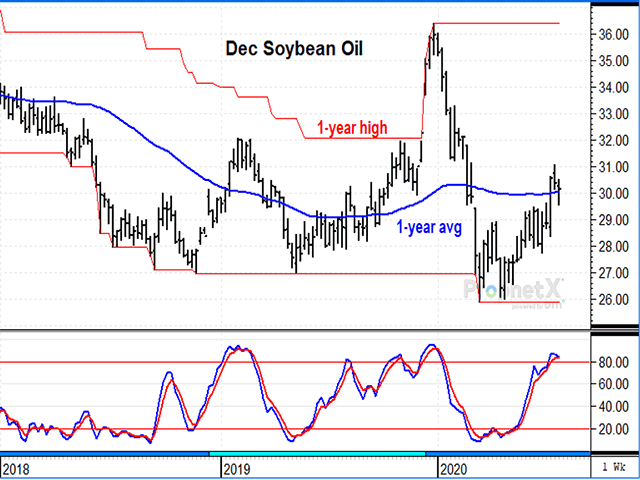Todd's Take
Soybean Oil Offering Bullish Help to Soybeans
Tuesday's corn and soybean prices took hits this week from USDA's higher good-to-excellent crop ratings and, in the case of corn, revived prospects for a record corn crop this fall. For soybeans, the new 72% crop rating is the second highest of the past 10 years for this time of year and has me estimating a 4.3-billion-bushel (bb) harvest, based on a 52 bushel per acre (bpa) yield.
The estimate is still a rough guess, as it is for all of us looking at lots of clues. The more reliable crop estimate starts on Sept. 11 when the World Agricultural Supply and Demand Estimates (WASDE) includes a field-based survey.
As far as soybean prices are concerned, a 4.3 bb crop estimate is a repeat of the record 2018 soybean crop and is somewhat bearish, but it is not soybeans' biggest worry. Brazil and the demand side of the market remain the greatest challenges for soybean prices.
Brazil has had expanded soybean plantings for at least 13 consecutive years and is almost certain to expand again this fall, weather permitting. FOB soybean prices in Brazil for September are trading at their highest level in two years, some 60 cents above comparable prices at the U.S. Gulf. That is bullish for U.S. export prospects now, but also offers Brazil's producers strong incentive for increasing soybean acres later this year.
Brazil's prices are so high because China was such an aggressive buyer in 2020 and the cupboards are nearly bare. USDA estimates Brazil's ending soybean stocks on Jan. 31, 2021, will total 101 million bushels (mb). Unofficially, we could add another 100 mb to Brazil's supply from Argentina, the result of smuggling encouraged by Argentina's higher export taxes.
With a large U.S. soybean crop probably on the way, the deciding vote for soybean prices in 2020-21 falls on demand. It is encouraging that new-crop soybean export sales are off to a strong start, now at 504 mb, with the new season still a month away.
P[L1] D[0x0] M[300x250] OOP[F] ADUNIT[] T[]
I don't pretend to read the mind of Chinese importers, but there is talk that weak La Nina conditions may arrive this fall. DTN Senior Ag Meteorologist Bryce Anderson explained that La Nina is associated with drier conditions in southern Brazil and Argentina, but not necessarily Mato Grosso. It may be one reason China is eager to lock up new-crop soybean sales now.
Of course, the entire issue of trade with China is vastly complicated as we proceed into the third year of trade dispute, bogged down by several layers of tariffs, including China's tariffs on U.S. soybeans and other ag products. On top of that, the list of heightened political disputes with China keeps growing with Hong Kong and the mutual closing of consulate offices.
Amid the uncertainties of soybean demand, one bright spot has emerged and is having a bullish -- or at least supportive -- impact on soybean prices in 2020, and that is soybean oil.
Soybean oil was one of the top performing ag futures in 2019 and suffered a sharp drop in early 2020. It has long played the role of the weak sister of soybean products, as soybean meal captured the demand attention for several years.
Since its March 18 low of 25.90 cents, December soybean oil has clawed its way back above 30 cents and is currently one of a handful of ag commodities that has outperformed the S&P 500 index during the past three months.
One of the factors helping soybean oil prices seems to be a revival of demand for vegetable oil prices in general. Malaysian palm oil is the leader of this group, currently trading near its highest prices in five months. November canola joined the bullish parade with a new six-month high on Wednesday, July 29.
The other thing helping soybean oil prices is an expectation for Malaysian palm oil production to be lower this year. Efforts to protect the country from the spread of coronavirus have kept out the foreign workers the industry relies on.
According to Argusmedia.com and the CEO of the Malaysian Palm Oil Association, Malaysia's palm oil yield could be down 10% to 25%, due to worker shortages (see https://www.argusmedia.com/…).
The bullish case for soybean oil heated up early Friday with the August contract trading at a new 5-month high and showing a premium above the September contract. August is now in delivery and the premium suggests strong commercial demand for owning the physical product.
With so many moving parts, trying to estimate new-crop U.S. soybean demand is more difficult than usual in 2020-21 and part of the frustration is that a few hundred million bushels here or there will make a big difference to the bottom line and in determining which way prices will go.
So far, soybean oil is one bullish piece of the puzzle, helping encourage crush demand and keeping November soybean prices near the $9.00 mark, even after Monday's higher crop rating. I can't guarantee how long China will remain actively interested in U.S. soybeans, but for 2020-21, soybeans are one crop that still has bullish possibility.
Todd Hultman can be reached at Todd.Hultman@dtn.com
Follow him on Twitter @ToddHultman
(c) Copyright 2020 DTN, LLC. All rights reserved.



